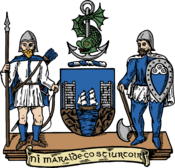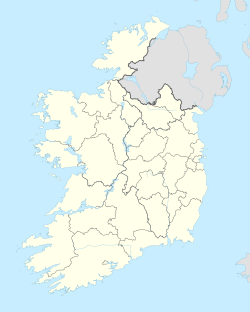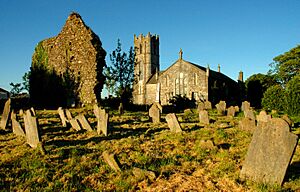Dungarvan facts for kids
Quick facts for kids
Dungarvan
Irish: Dún Garbhán
|
||
|---|---|---|
|
Town
|
||
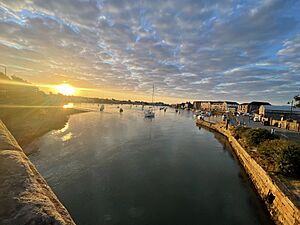
Dungarvan's harbour
|
||
|
||
| Motto(s):
Ní Maraidhe Go Stiúrthóir
Can't Have a Mariner Without a Steersman |
||
| Country | Ireland | |
| Province | Munster | |
| County | Waterford | |
| Area | ||
| • Total | 4.63 km2 (1.79 sq mi) | |
| Elevation | 1 m (3 ft) | |
| Population
(2022)
|
10,081 | |
| Time zone | UTC±0 (WET) | |
| • Summer (DST) | UTC+1 (IST) | |
| Eircode routing key |
X35
|
|
| Telephone area code | +353(0)58 | |
| Irish Grid Reference | X259930 | |
| Website | waterfordcoco.ie | |
Dungarvan is a lively coastal town and harbour in County Waterford, Ireland. It's located on the south-east coast of the country. The town's Irish name, Dún Garbhán, means 'Garbhann's Fort'. This name comes from Saint Garbhann, who started a church here in the 600s.
Dungarvan was once the main administrative town for County Waterford. This was before 2014, when the local councils merged. In 2022, about 10,081 people lived in Dungarvan. This makes it the third largest town in the county.
Contents
Exploring Dungarvan: Location and Travel
Dungarvan is easy to reach. It sits on the N25 road, which connects big cities like Cork and Waterford. The town is about 40 kilometers (25 miles) from Waterford and 60 kilometers (37 miles) from Cork.
The Colligan River flows through Dungarvan. It divides the town into two parts: Dungarvan itself and Abbeyside. These two areas are connected by bridges and causeways. One famous bridge was built by the Dukes of Devonshire way back in 1801.
Getting Around Dungarvan
Road Connections
Dungarvan is on the N25 national road. This road is part of a larger European route. Other regional roads also pass through the town.
Sea Travel
Dungarvan has a harbour that opens to a wide bay. A special channel helps boats navigate into the town from the sea. This channel is marked with buoys. It's important for boats to stay in the channel, especially at low tide. There's a concrete ramp where small boats can be launched.
Bus Services
Many bus routes serve Dungarvan. You can catch buses to Cork, Waterford, and even Rosslare Europort. There are also local bus services that connect Dungarvan to nearby towns like Tallow and Lismore.
Old Railway Line
Dungarvan used to have a railway station until 1967. The old railway line has now been turned into the Waterford Greenway. This is a popular path for walking and cycling.
Dungarvan's Past: A Look at History
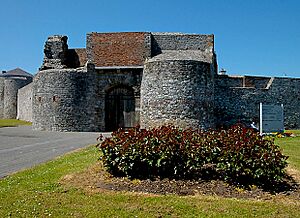

People have lived in the Dungarvan area for a very long time. There are signs of ancient settlements, like old stones and forts. Some people believe the town might have been started by Vikings. Evidence shows that people from Viking times lived here around the 900s.
Dungarvan Castle and Early Buildings
Dungarvan Castle is a historic building by the harbour. It was built in the early 1200s by King John of England. The castle stands where an even older fort might have been.
In the 1200s, an Augustinian abbey was founded in Dungarvan. Today, Saint Augustine's Catholic Church stands on that same spot. Another old church from the 1200s is found near Saint Mary's church on the other side of the harbour.
Important Events
Dungarvan became an official town in the 1400s. It used to send members to the Irish Parliament. Later, it sent one member to the British Parliament until 1885. During the Cromwellian conquest of Ireland in the mid-1600s, Dungarvan gave up without a fight.
In 1859, something amazing was found in the town: the remains of a woolly mammoth!
A lifeboat station was set up in Dungarvan in 1859 to help people at sea. It later moved to Helvick. In 1921, an event called the Burgery ambush happened near the town during the Irish War of Independence.
Irish Language in Dungarvan
The Irish language is important in Dungarvan. About 3% of the people in the town speak Irish every day, outside of school. There's an Irish language school called Scoil Garbhán for young children.
Many activities happen to help keep the Irish language strong. Businesses in Dungarvan can even win an award for promoting Irish. The town also has an office for Glór na nGael, a group that works to spread the Irish language across Ireland.
Dungarvan is also close to the Gaeltacht na nDéise area. This is a special region where Irish is the main language spoken.
Working in Dungarvan: Local Industry
Dungarvan has some important businesses. GlaxoSmithKline, a big company that makes consumer products, has a factory here. It employs many people. Radley Engineering, another company in Dungarvan, even helped make the famous Spire of Dublin.
In the past, Dungarvan had a tannery, a distillery, and a fishing fleet. The Dungarvan Cooperative, a creamery, was also a big employer.
Dungarvan's Connections: Twin Towns
Dungarvan has a special connection with Erie, Pennsylvania in the United States. They became "twin towns" in 2007.
Students and teachers from Mercyhurst University in Erie often visit Dungarvan. They come to study and learn. The university even has a research center in Dungarvan.
In 2018, Dungarvan won a silver medal in the Entente Florale competition. This competition celebrates beautiful towns and landscapes in Europe.
Dungarvan in Books and Poems
Dungarvan has been mentioned in many famous writings.
Tadhg Gaelach Ó Súilleabháin, an Irish poet from the 1700s, lived in Dungarvan. He wrote many Christian poems in Irish.
The British poet Sir John Betjeman wrote a poem that mentions Dungarvan. Each part of his poem ends with the line, "Dungarvan in the rain."
The town is also mentioned in a collection of short stories called Labyrinths by Jorge Luis Borges. It also appears in the 2002 novel The Story of Lucy Gault by William Trevor.
Famous People from Dungarvan
Many talented people come from Dungarvan, including:
- Niamh Briggs, a rugby player
- Moe Dunford, an actor
- Maura Derrane, a television presenter
- Michael Lyster, a television broadcaster
- Ernest Walton, a physicist who won a Nobel Prize
Images for kids
See also
 In Spanish: Dungarvan para niños
In Spanish: Dungarvan para niños


